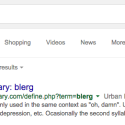One of the fundamental aspects of doing SEO work is to analyze the competition that exists on the web for a particular search term. We SEO consulting folks use fancy keyword tools to figure out how many pages on the web contain a particular term in their page content, and even more importantly, in the page Title tag and within the URL. What many people don’t realize is that this data, which often comes directly from search engines, is often LYING… well, sort of.
Any user who knows how to do it can analyze SEO competition on their own, by starting with a special type of search. Let’s say you want to know how many pages on the web are currently optimized for the keyword term “lefty golf club“. You can do the following search in Google:
allintitle:”lefty golf club”This query is asking the search engine to bring back to you all the pages that have “lefty golf club” as part of the Title tag of the page, which is useful to know because the Title tag is a critical element used to optimize a page for search. If there are too many pages already using this phrase, it could be very hard to rank for it.
As you can see here, right below the search bar Google let’s you know there are about 1,050 results with this EXACT phrase in the tag (the quotes in the query make it exact). You might say “whoa, too hard to break into the top ten”, and move onto another phrase.
But wait…! Scroll to the bottom of the page, where it shows that there are only 9 pages of search results to look at. Hmmm… at ten results per page, this indicates only 90 webpages returned for this search.
Now here’s the BIG LIE revealed… click on the number for the last page (9 in this case), and see what happens. Instead of taking to to page 9, it takes you to the bottom of Page 5 of the results, and now Google changes its tune, showing the following:

So now we’re down to only 49 results from the original 1,050 Google said it was returning to us in the SERP (search engine result page)? Well, if I were trying to target an SEO effort towards this phrase, I would feel very differently about these two scenarios.
What Google is doing is simply showing you the original figure of all the pages which do, in fact, have the phrase in their Title tag, but then when you really start exploring the results, they limit the SERPs to only those pages that they consider non-duplicative. So sites that have the same content across different urls, or two sites that posted the same article, get filtered down so that Google can give you a unique set of results that won’t leave you frustrated by clicking through to find the same content. So they were lying to you, but it was a useful lie… for your own good!
If you are digging deep on an SEO effort, little tricks like this can make a big difference in sorting out truly competitive keywords from those that are perhaps within reach. The old adage is still true… don’t believe everything you read.
Read more about keyword research help.











I wrote a paper on this in College, had i had your capability to articulate my thoughts and research, I may possibly have received a far better grade. Good Job!
Gran post, muchas gracias.
Good post, adding it to my blog now, thanks.
thanxx
Good Afternoon
Definitely gonna recommend this post to a few friends